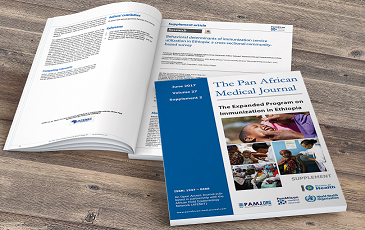A particular appearance of a diaphragm pannus completely masking a mechanical mitral valve: a case report
Yassine Morjane, Manal Msirdi, Zakaria Bazid, Nabila Ismaili, Noha Elouafi, Hicham El Malki, El Mehdi Moutaouekkil
Corresponding author: Yassine Morjane, Department of Cardiovascular Surgery, Mohammed VI University Hospital Center, Oujda, Morocco 
Received: 14 Mar 2025 - Accepted: 08 Apr 2025 - Published: 30 Apr 2025
Domain: Cardiology,Cardiovascular surgery
Keywords: Pannus, mechanical valve prosthetic, echocardiography, cinefluoroscopy, case report
Funding: This article has no funding header section. You can add it here
©Yassine Morjane et al. Pan African Medical Journal (ISSN: 1937-8688). This is an Open Access article distributed under the terms of the Creative Commons Attribution International 4.0 License (https://creativecommons.org/licenses/by/4.0/), which permits unrestricted use, distribution, and reproduction in any medium, provided the original work is properly cited.
Cite this article: Yassine Morjane et al. A particular appearance of a diaphragm pannus completely masking a mechanical mitral valve: a case report. Pan African Medical Journal. 2025;50:115. [doi: 10.11604/pamj.2025.50.115.47267]
Available online at: https://www.panafrican-med-journal.com//content/article/50/115/full
Case report 
A particular appearance of a diaphragm pannus completely masking a mechanical mitral valve: a case report
A particular appearance of a diaphragm pannus completely masking a mechanical mitral valve: a case report
![]() Yassine Morjane1,&,
Yassine Morjane1,&, ![]() Manal Msirdi2, Zakaria Bazid2,3, Nabila Ismaili2,3, Noha Elouafi2,3, Hicham El Malki 1,3, El Mehdi Moutaouekkil1,3
Manal Msirdi2, Zakaria Bazid2,3, Nabila Ismaili2,3, Noha Elouafi2,3, Hicham El Malki 1,3, El Mehdi Moutaouekkil1,3
&Corresponding author
In this article, we report the case of a 58-year-old man who was admitted to our institution with acute dyspnea and poor hemodynamic condition. He had undergone double mitral-aortic valve replacement five years earlier for rheumatic heart disease. Transthoracic echocardiography (TTE), cinefluoroscopy, and transesophageal echocardiography (TEE) revealed a significant reduction in the opening of the mechanical mitral valve leaflets. An urgent redo surgery was performed, during which the pannus was removed, ensuring the restoration of normal leaflet motion. This clinical case presents two rare circumstances: first, the unusual diaphragmatic pannus completely masking the mechanical mitral prosthetic valve, and second, the development of pannus at the level of the mitral mechanical prosthesis rather than the aortic mechanical prosthesis.
Mechanical valve prostheses have the advantage of a long service life, with thrombosis and pannus being the main causes of malfunction, potentially leading to prosthetic blockage [1,2]. Thrombotic complications are more common in the early postoperative period, whereas pannus typically develops later [3]. We report a case of bileaflet mechanical valve failure in the mitral position due to an unusual pannus formation, necessitating reoperation.
Patient information: a 58-year-old man with no cardiovascular risk factors underwent double heart valve replacement for severe rheumatic mitral and aortic stenosis using 31mm and 21mm Carbomedics mechanical prosthetic heart valves.
Timeline of current episode: five years later, the patient was admitted to the cardiology department with acute dyspnea and hemodynamic instability, with no reported history of fever or chest pain.
Clinical findings: physical examination revealed shortness of breath, polypnea, a decrease in oxygen saturation to 80%, tachycardia, and hypotension. Cardiac auscultation showed diminished closing clicks of the mitral prosthetic valve, while pulmonary auscultation revealed crackling rales at the apices. The electrocardiogram demonstrated atrial tachyarrhythmia at 150 beats per minute (Figure 1).
Diagnostic assessment: biological examinations revealed a hemoglobin level of 12.2 g/dL, a biological inflammatory syndrome with a C-reactive protein level of 264 mg/L, and neutrophil-predominant hyperleukocytosis of 18,500/mm3, while renal and liver function tests were within normal limits. Transthoracic echocardiography showed a blocked leaflet of the mitral prosthetic valve without any thrombus image on either the ventricular or atrial side, while the aortic prosthetic valve function remained normal. The mitral trans-prosthetic pressure gradient was significantly elevated, with a mean gradient of 18.09 mmHg (Figure 2). The effective mitral orifice area, calculated using the continuity equation, was 0.8 cm2, and the Doppler velocity index was 3.3, all indicating significant obstruction of the mitral prosthesis. The left ventricle was not hypertrophied and had preserved global function (ejection fraction of 57%), whereas the right ventricle was dysfunctional with severe pulmonary hypertension. To assess the motion of the prosthetic leaflets, cinefluoroscopy was performed (Figure 3). It revealed a limited opening of the mitral prosthetic leaflets, with a diastolic opening angle of 70°, compared to the normal value of less than 24° for a Carbomedics mitral bileaflet mechanical prosthesis. The systolic closure of the leaflets remained preserved, with a closing angle of 133° (the normal value for the Carbomedics mitral bileaflet mechanical prosthesis is >130°).
Diagnosis: three main diagnoses were considered: a mitral prosthetic thrombus, which was deemed less likely due to the absence of thrombus visualization on echocardiography; infective endocarditis, which remained a possibility given the biological inflammatory syndrome. The patient was considered at high risk for endocarditis despite the absence of other minor or major modified Duke diagnostic criteria; and finally, the presence of a pannus formation, which was highly suggestive due to the five-year interval before symptom onset.
Therapeutic interventions: the acute pulmonary edema caused by the complete blockage of one of the two prosthetic leaflets in our patient represented a surgical emergency. The patient was placed on oxygen, inotropes, and furosemide, but showed no clinical improvement, necessitating surgery. A median redo sternotomy was performed, and conventional cardiopulmonary bypass was established. Myocardial protection was achieved with a single dose of custodial after cross-clamping. A left atriotomy was then carried out, revealing a left atrium completely free of thrombosis. Inspection showed a highly unusual diaphragmatic pannus completely covering both leaflets, almost entirely restricting their opening (Figure 4). A complete resection of the pannus was performed, restoring normal leaflet function (Figure 5).
Follow-up and outcome of interventions: postoperative TEE assessment of the mitral and aortic prosthetic valves was satisfactory, and the patient was transferred to the intensive care unit. The postoperative recovery was uneventful.
Patient perspective: the patient expressed optimism for a full recovery.
Informed consent: the patient provided written consent for the publication of his clinical details and any identifying images.
A number of complications can arise after valve replacement surgery, some of which are common to all cardiac surgeries, while others are specifically related to prosthetic valves. Blockage of a prosthetic valve is a rare but potentially fatal complication [1,2]. The main causes are thrombosis and pannus formation around the prosthesis, with the latter typically occurring later after surgery [3]. Pannus is a fibrous tissue that develops around cardiac prostheses, usually in an annular location, as a response to blood stasis and local inflammation [4]. Its development primarily depends on patient-related factors, the type of prosthesis, its design, size, and location. Pannus is more commonly observed on aortic prostheses than mitral ones, and when it occurs in the mitral position, it is usually located on the atrial side of the prosthesis. Additionally, the presence of pannus can predispose the valve to thrombosis, while chronic thrombosis of a cardiac prosthesis can also trigger pannus formation [4,5]. Symptoms vary depending on the severity of prosthetic dysfunction [1-6]. The incidence of such dysfunction in cardiac prostheses is reported to range between 0.1% and 6% per year [7], and in most cases, it occurs several years after valve surgery. However, valve dysfunction due to early pannus formation has been repeatedly documented, with the first cases diagnosed between 1 and 12 months post-surgery. Shi et al. reported a rare case of early pannus formation on a mitral prosthesis just three months after surgery [8], while Cleveland et al. described a case occurring one month after aortic valve replacement [9].
The exact mechanism behind excessive pannus formation in some patients remains unclear, but it has been linked to various factors, including rheumatic fever, atrial fibrillation, low cardiac output, high transprosthetic gradients, small valve size, and ineffective anticoagulation [5]. This article highlights a rare circumstance: the development of pannus on the mitral mechanical prosthesis rather than on the aortic mechanical prosthesis, despite both valves being replaced in the same operation. A possible explanation could be left atrial dilation, inadequate anticoagulation, and atrial fibrillation, which may promote pannus formation and obstruction even with a larger-diameter mitral prosthesis. In contrast, the high hemodynamic stress and large vascular bed distance in the aortic position may have provided a protective effect against pannus formation. Clinical diagnosis and confirmation through imaging remain challenging. The most effective diagnostic tools include TTE, TEE, fluoroscopy, and axial computed tomography. The therapeutic approach depends on several factors, including the severity of valve obstruction, the patient's clinical condition, and the prosthesis location. Redo surgery is recommended in cases of critically symptomatic mechanical valve obstruction [1-6]. In our case, the patient presented with acute pulmonary edema due to complete blockage of one of the two leaflets. Despite oxygen therapy and medical treatment with inotropes and furosemide, there was no clinical improvement. Given the critical situation, a heart team discussion led to the decision for reoperation. We strongly suspected that the obstruction was primarily due to pannus formation, which was subsequently confirmed intraoperatively.
We would like to draw the doctor's attention to two rare aspects of our clinical case: first, the unusual diaphragmatic pannus completely obscuring a mechanical mitral prosthetic valve, and second the development of pannus on the mitral mechanical prosthesis rather than on the aortic mechanical prosthesis, despite both valves being replaced in the same operation.
The authors declare no competing interests.
Patient management, data collection, manuscript drafting: Yassine Morjane and Manal Msirdi. Manuscript revision: Yassine Morjane, Manal Msirdi and El Mehdi Moutaouekkil. All the authors have read and agreed to the final manuscript.
Figure 1: electrocardiogram at admission
Figure 2: increased gradient across the mitral prosthetic valve
Figure 3: cinefluoroscopy: A) diastolic image showing both mitral discs not fully open, with an opening angle of 70° (normal value for the Carbomedics mitral bileaflet mechanical prosthetic valve is <24°); B) systolic image showing a closing angle of 133°(normal value for the Carbomedics mitral bileaflet mechanical prosthetic valve is >130°)
Figure 4: intraoperative view showing an unusual diaphragmatic pannus completely obscuring a mechanical mitral prosthetic valve
Figure 5: A, B) intraoperative view showing complete pannus resection
- Roudaut R, Serri K, Lafitte S. Thrombosis of prosthetic heart valves: diagnosis and therapeutic considerations. Heart. 2007 Jan;93(1):137-42. PubMed | Google Scholar
- Gazi E, Altun B, Temiz A, Colkesen Y. Successful thrombolytic treatment of prosthetic mitral valve thrombosis. BMJ Case Rep. 2013 Jun 7:2013:bcr2013009917. PubMed | Google Scholar
- Rizzoli G, Guglielmi C, Toscano G, Pistorio V, Vendramin I, Bottio et al. Reoperations for acute prosthetic thrombosis and pannus: an assessment of rates, relationship and risk. EEur J Cardiothorac Surg. 1999 Jul;16(1):74-80. PubMed | Google Scholar
- Tabet JY, Bouvier E, Cormier B, Donzeau-Gouge P, Fourchy D, Seknadji P et al. Unusual cause of stroke after mitral valve replacement. Circulation. 2010 Oct 12;122(15):e484-5. PubMed | Google Scholar
- Teshima H, Hayashida N, Yano H, Nishimi M, Tayama E, Fukunaga S et al. Obstruction of St Jude Medical valves in the aortic position: histology and immunohistochemistry of pannus. J Thorac Cardiovasc Surg. 2003 Aug;126(2):401-7. PubMed | Google Scholar
- Tirolimis T. Acute thrombosis of mechanical bi-leaflet aortic valve prosthesis. J Cardiovasc Dis Res. 2012 Jul;3(3):228-30. PubMed | Google Scholar
- Ma WG, Hou B, Abdurusul A, Gong DX, Tang Y, Chang Q et al. Dysfunction of mechanical heart valve prosthesis: Experience with surgical management in 48 patients. J Thorac Dis. 2015 Dec;7(12):2321-9. PubMed | Google Scholar
- Shi J, Bai Z, Hu J, Zhang B, Guo Y. Rare early prosthesis obstruction after mitral valve replacement: a case report and literature review. J Cardiothorac Surg. 2012 Jul 2:7:64. PubMed | Google Scholar
- Cleveland JC, Lebenson IM, Dague JR. Early postoperative development of aortic regurgitation related to pannus ingrowth causing incomplete disc seating of a Bjork-Shiley prosthesis. Ann Thorac Surg. 1982 May;33(5):496-8. PubMed | Google Scholar
Search
This article authors
On Pubmed
On Google Scholar
Citation [Download]
Navigate this article
Similar articles in
Key words
Tables and figures
 Figure 3: cinefluoroscopy: A) diastolic image showing both mitral discs not fully open, with an opening angle of 70° (normal value for the Carbomedics mitral bileaflet mechanical prosthetic valve is <24°); B) systolic image showing a closing angle of 133°(normal value for the Carbomedics mitral bileaflet mechanical prosthetic valve is >130°)
Figure 3: cinefluoroscopy: A) diastolic image showing both mitral discs not fully open, with an opening angle of 70° (normal value for the Carbomedics mitral bileaflet mechanical prosthetic valve is <24°); B) systolic image showing a closing angle of 133°(normal value for the Carbomedics mitral bileaflet mechanical prosthetic valve is >130°)















